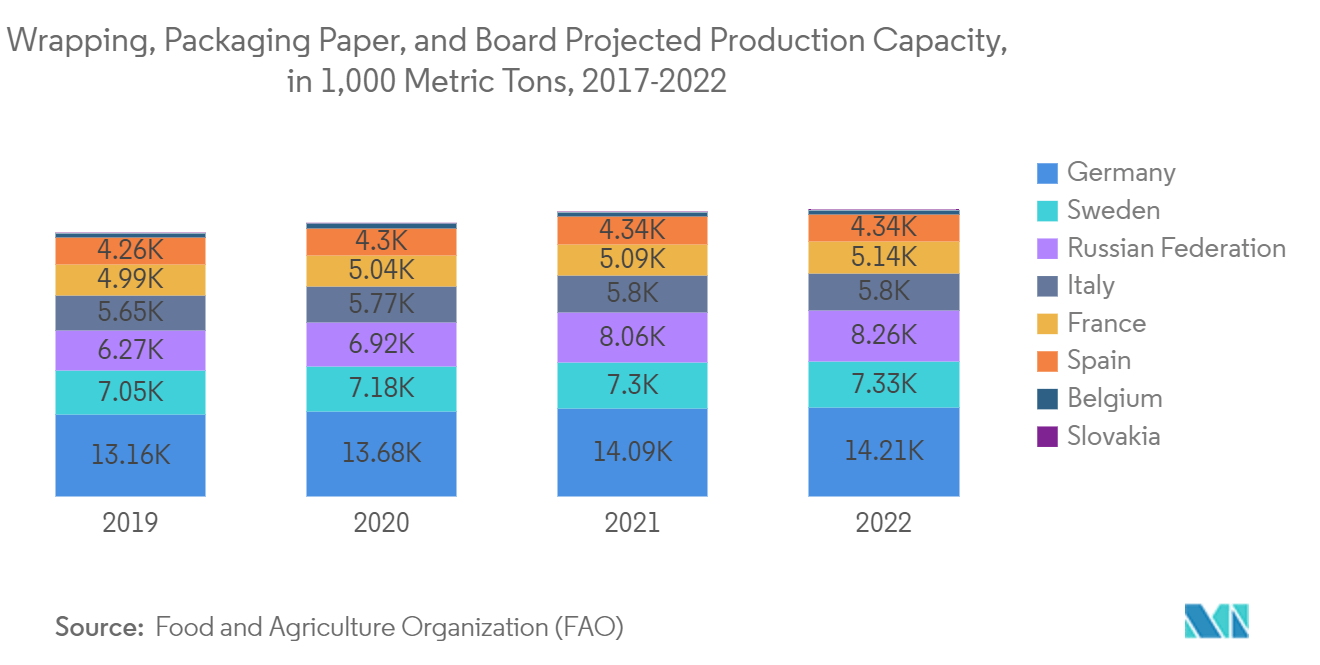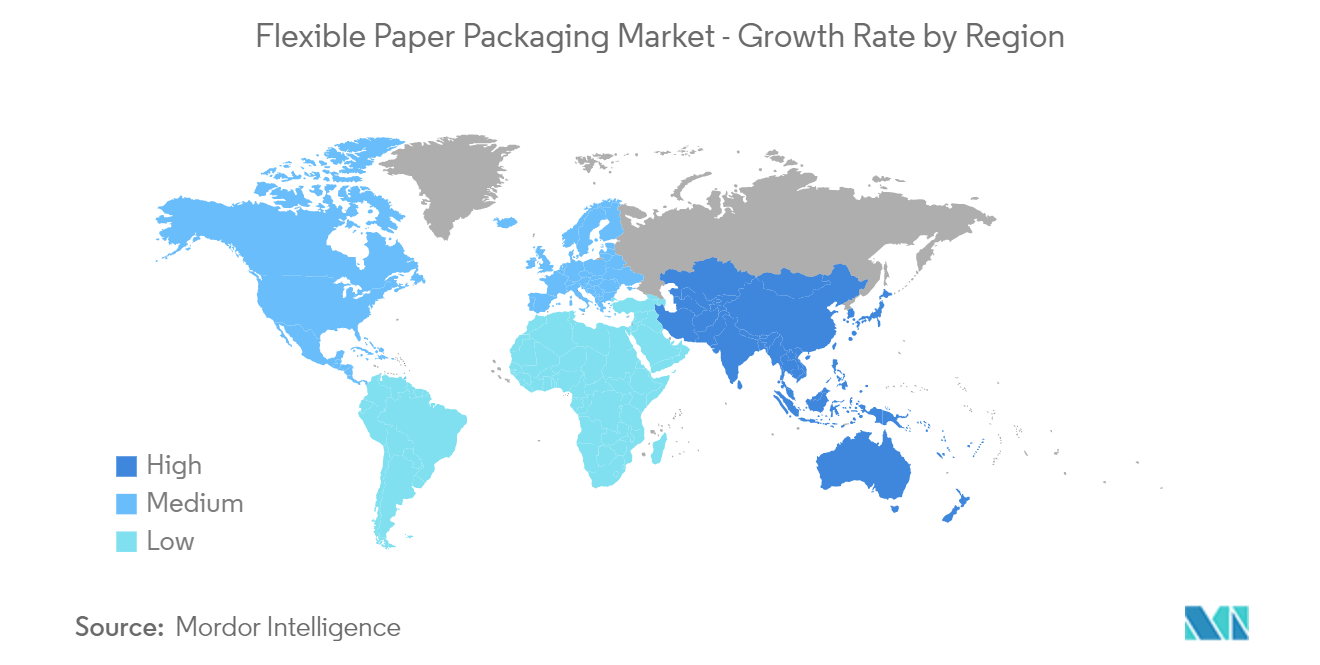Market Trends of Flexible Paper Packaging Industry
This section covers the major market trends shaping the Flexible Paper Packaging Market according to our research experts:
Consumers’ Preference for Sustainable Packaging
- The packing industry has undergone a massive transformation in recent years, owing to an increase in the number of start-ups around the world, the introduction of diverse categories of food and non-food products, and increased demand for food and beverages during the pandemic.
- There is an increasing awareness of the negative environmental impact of using various pollutant materials for packaging purposes. Environmentally conscious consumers are looking for environmentally friendly and long-lasting packaging materials. Consumers worldwide are becoming interested in biodegradable and recyclable packaging papers. As a result, manufacturers in the flexible packaging paper market are increasing their production capacity to meet demand from various end-use industries globally.
- Governments are also increasing awareness about the advantages of environmentally friendly, lightweight, and recyclable packaging papers. This flexible packaging paper is non-hazardous to the environment. The growing trend of using eco-friendly packaging solutions propels the flexible packaging paper market forward.
- Reduced production of single-use plastic, viewed by sustainability experts as one of the most harmful packaging types and has resulted in a severe accumulation of waste globally, particularly in oceans, is a critical component. Nestlé and PepsiCo have set goals of making 100% of their packaging recyclable, reusable, or compostable by 2025.
- Nestlé expands its paper presence, with its Japanese subsidiary introducing recyclable paper packaging for its KitKat products. Nestlé has also announced the introduction of a second product in paper packaging. The Nesquik All Natural powder will get packaged in a recyclable paper pouch that has been Forest Stewardship Council certified. Recently, the company introduced its YES! bars in recyclable paper. It aligns with the company's goal of making its packaging recyclable or reusable by 2025.
- Furthermore, Mondelēz International, a global snack company, is committed to making all its packaging recyclable by 2025. In line with its strategy to deliver zero-net waste packaging, the company launched its Cadbury Energy bar in New Zealand in December with new packaging made from 100% recyclable and sustainably sourced paper. According to Confectionary News, for the first time, the company has used a paper material that does not include laminates, foils, or plastics for fully-sealed flow-wrap packaging. Also, As an alternative to the existing thermoformed plastic blister package, Sonoco Alloyd introduced an all-paper retail blister package.
- There has been a rapid shift toward promoting sustainable items for packaging rather than traditional plastics. It is primarily due to the growing popularity of sustainability among people all over the world. Flexible packaging will revolutionize the entire packaging industry, particularly regarding sustainability, considering the accumulation of massive waste and environmental deterioration caused by dumping conventional packaging materials. It has enabled numerous manufacturers worldwide to devise creative strategies to minimize the amount of packaging waste and incessantly adopt flexible packaging in their products.

Demand from End-Use Industries such as, Food & Beverages, Beauty & Personal Care and Others
- Paper bags meet consumer demand for safe, leak-proof, recyclable packaging. In areas where takeout and online food delivery are becoming popular, paper bags are gradually replacing plastic packaging solutions. Paper packaging will meet rising demand from the food and beverage industries.
- The Asia Pacific region will grow due to the demand that will likely expand in the area due to its significant potential expansion. As the focus changes to eco-friendly and sustainable practices, paper packaging demand has been growing across several industries in the Asia Pacific, including food and beverage, healthcare, personal care, home care, retail, and others.
- Furthermore, the use of packaging materials has increased in tandem with the growth of the e-commerce industry. On the other hand, the food & beverage industry has taken the lead, with an increasing number of companies revising their packaging strategies. Companies in the food and beverage industries are looking for environmentally friendly alternatives to traditional packaging materials such as wrappers, cartons, bottles, and other options.
- Companies are increasingly using flexible packaging paper for packaging in various end-use industries. The increasing use of flexible and lightweight packaging paper in food, pharmaceuticals, agriculture, personal care and cosmetics, and consumer goods creates value-added opportunities for market participants. The most profitable market for flexible packaging paper solutions is the food industry. Consumption of ready-to-eat and frozen foods is increasing worldwide, creating lucrative opportunities for manufacturers in the flexible packaging paper market.
- Furthermore, rising disposable income, changing lifestyles, and demand for convenience food items are driving demand for flexible packaging paper solutions used for packaging food items such as dairy products, grains, fruits and vegetables, bakery and confectionaries, and other ready-to-eat products. The rising popularity of these food products in developing and underdeveloped countries helps to drive market growth.
- The increasing use of flexible paper packaging in various end-use industries such as healthcare, personal care, food & beverages, and consumer goods will drive the market forward. In addition, other factors like rising disposable income, growing working population, and increasing demand for packed food will soon contribute to the market growth for flexible paper packaging.
- The eCommerce market has increased significantly, accounting for approximately 20% of global retail sales in 2021. The companies are distributing a broader range of goods, necessitating packaging of various sizes, shapes, and strengths. According to Mondi's annual consumer trend research, online retailers actively seek practical packaging solutions that ensure optimal protection of goods shipped while also being environmentally friendly - 82% of customers prefer recyclable eCommerce packaging.

